“Meditating has never been this easy!”
Hailed as “the flagship app for French-speaking meditators”, and now also offering guidance in Dutch, English, German, Italian and Spanish, Petit BamBou (“little bamboo”) was officially launched by web entrepreneurs Ludovic Dujardin and Benjamin Blasco in 2015. With the aim of making the practice of mindfulness meditation more accessible to the general public, the app offers a catalogue of over 300 guided meditation sessions across each language, and currently has over 6.6 million users worldwide.
Petit BamBou feature overview
With its clean, elegant interface, Petit BamBou is remarkably easy to navigate and divides itself into four main sections. The Meditation tab can be used to track one’s current session, with the Programs tab offering a vast array of meditations, organised according to theme. The Sounds section offers a catalogue of relaxing sounds and music which can be used to accompany unguided sessions, whilst the Me tab provides the user with information regarding their practice – such as the cumulative number of hours for which they have meditated.
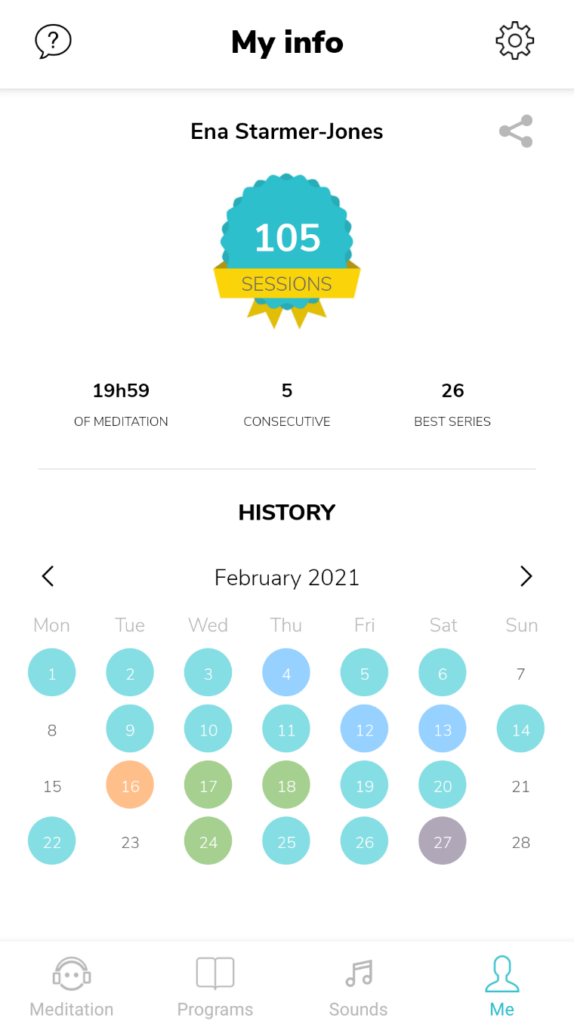
The Petit BamBou meditation programs
The meditations offered by Petit BamBou are generally between ten and twenty minutes in length, and are organised into programs of between eight and twenty-five sessions, designed to be followed chronologically. Programs are arranged on the app according to theme, which includes topics such as “Progression”, “Sleep”, “Mind” and “Work”, therefore making it easy to locate a particular program to suit the purpose of one’s meditation.
Petit BamBou is well-suited to the beginner, as its “Progression” set of meditations assumes no prior knowledge of contemplative practice. Gradually, we are introduced to ways in which to ground ourselves in the present moment, such as by observing each inhalation and exhalation and becoming aware of the physical sensations of the body. In the early meditations of this series, there is considerable focus on the concept of self-compassion: an encouragement to accept and embrace any resistance towards meditating; to meet any perceived shortcomings with kindness and curiosity. With this gentle encouragement, I would recommend Petit BamBou as an effective starting point for the beginner meditator, as it allows one to explore the concept of meditation without being held back by self-criticism.
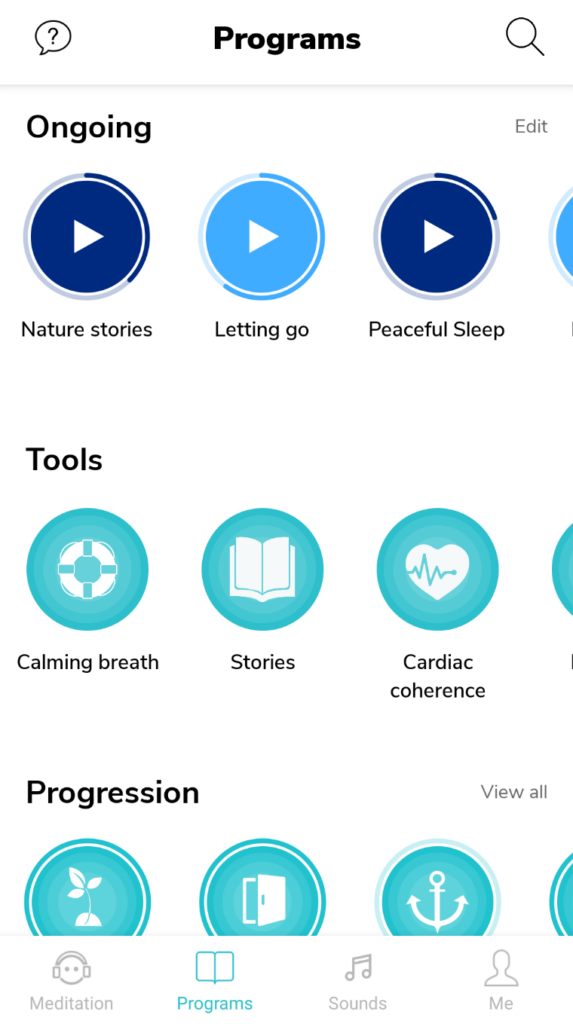
However, towards the latter end of the “Progression” set of programs, the guidance appears at times to become more vague in nature- such as when we are instructed, for example, to “notice [our] posture in relation to [our] thoughts and remember the associated sensations”. Such ambiguity is arguably problematic; I found this request, among others, to take me out of a meditative state and into my mind as I tried to intellectualise what exactly was being asked of me. At times, it appeared as though the instruction was made deliberately ambiguous in order to “prove” a level of advancement from previous meditations in the series; however, the fact that earlier sessions provide a solid grounding for one’s practice means that it is easy to switch to an unguided session here if this is an issue.
One way in which Petit BamBou distinguishes itself from its competitors is through the sheer diversity of sessions that it has to offer. Although covering popular themes such as compassion, stress management, sleep and letting go, the app also offers meditations on more specific topics such as mindful time management, sports, food and pain. I found the course on embracing pain to be particularly outstanding as a means to deal with both physical and emotional discomfort; its gentle guidance to observe rather than react to these sensations allowed me to cultivate a sense of spaciousness, curiosity and compassion that I sometimes found difficult to achieve in my independent practice. In addition, I particularly appreciated the meditation on the concept of the “second arrow” for its reminder that our attitude towards pain can enable us to avoid amplifying our own suffering.
A multi-lingual meditation app
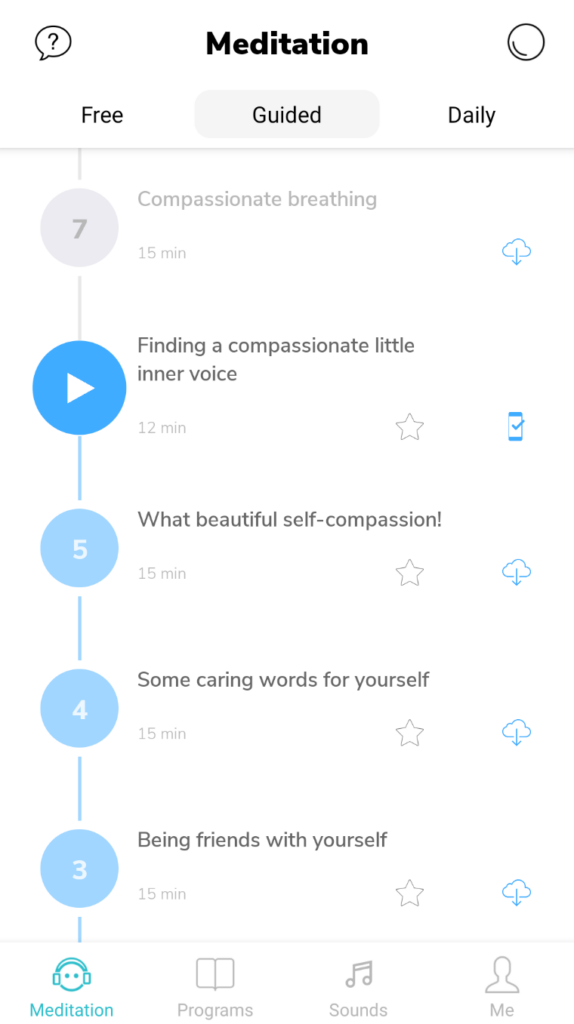
Petit BamBou also offers its meditations in Dutch, German, French, Italian and Spanish – ideal for the bilingual or non-native English speaker. The programs offered vary across the languages; however, the quality of the meditations appears to remain consistent.
Meditating in a second language
Speaking German as a second language, I was able to explore the German section of the app, where I particularly enjoyed the “Bewusst im Alltagsleben” (mindful in everyday life) set of meditations – designed to be listened to whilst undertaking activities such as ironing and washing up, and therefore bridging the gap between formal practice and everyday life.
Meditating in a second language was a new experience for me, and one that I found to offer both benefits and drawbacks. Initially I found it quite difficult to relax into the experience, as although I could generally understand the guidance quite well, I could observe how my mind did not quite trust this fact and wished to remain vigilant: hyper-focused on understanding each word and phrase rather than simply allowing these to wash over me.
I also noticed that I was far more aware of the tone and timbre of the narration whilst meditating in German, and that this affected me more significantly than in my native tongue. I experienced a greater sense of internal resistance, for example, when meditating with the “Trauer” (sadness) set of meditations, as a perceived coldness in the narrator’s voice made me feel less at ease. Overall, however, I enjoyed the experience of meditating in a second language, as it offered a practice for trusting and letting go: requiring that I set an intention for tuning into my body, and trusting that the words and their meaning would naturally permeate my consciousness without me having to focus on them entirely.
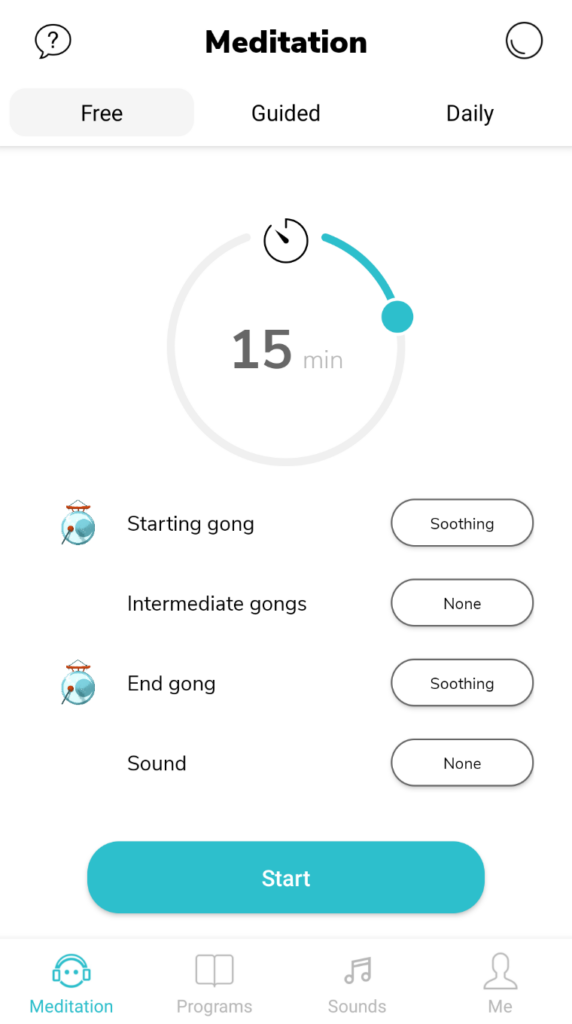
Meditation tools in Petit BamBou
Petit BamBou also offers a number of tools to assist with both guided and unguided practice, which are predominantly located under the Programs tab. There is the Calming breath tool, for example, which offers three minutes of silence in order to invite the user to come back to themselves, as well as the Stories tool, which uses animation to explain the principles of meditation. There are also the Favorites and Downloads features for accessing starred or downloaded meditations, as well as a Reminder button to provide future notifications to encourage the user to meditate.
A meditation timer and daily meditation tool are also included in the app, with these located under the Meditation tab. For the timer, the user is able to select any duration between one and ninety minutes for their practice, as well as being able to choose from a vast selection of background sounds and music if desired. With regard to the daily meditation, each session is offered in an eight-, twelve- and sixteen-minute format, therefore enabling the user to tailor their practice to their everyday life.
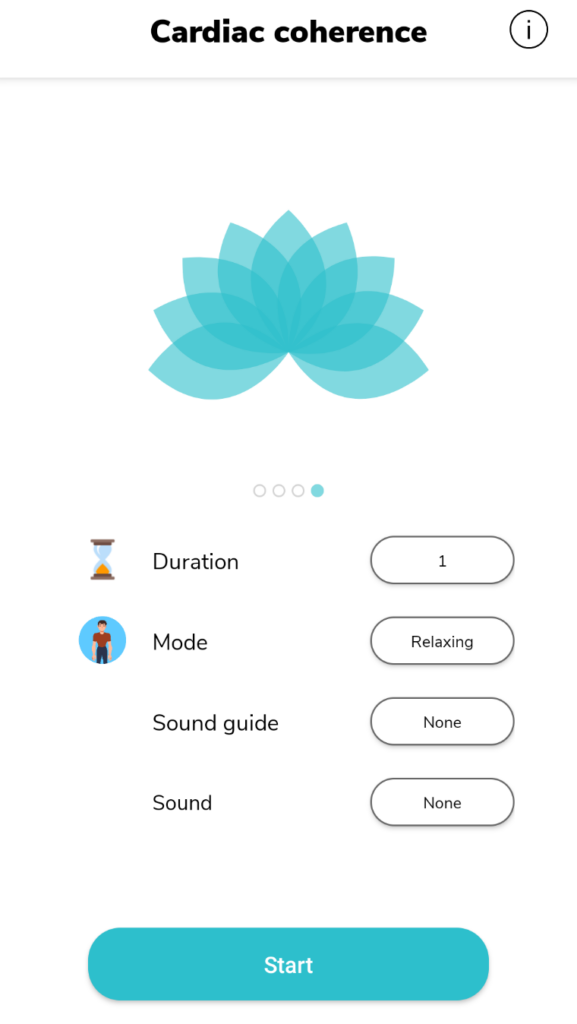
The cardiac coherence tool for breathwork
Petit BamBou also enables the application of breathwork techniques through the use of its Cardiac coherence tool, located under the Programs tab. This involves syncing one’s breathing with a visual aid (a circle, spiral or lotus symbol)- breathing in as the image expands and breathing out as the image contracts. For this exercise, the user is able to choose from a variety of different modes such as “Relaxing” and “Energizing”, which varies the length of each inhalation and exhalation. There is also an additional option for adding background sounds and music.
Unfortunately, I did not find the “Cardiac coherence” tool to be particularly helpful, in the way that it did not appear to accommodate the pause which organically arises between each in-breath and out-breath when one is breathing naturally. As a result, I consistently felt slightly rushed at the beginning of each inhalation and exhalation as I sought to “catch up” with the timing of the visual aid, therefore rendering this exercise a slightly stressful rather than stress-reducing experience.
Petit BamBou stories
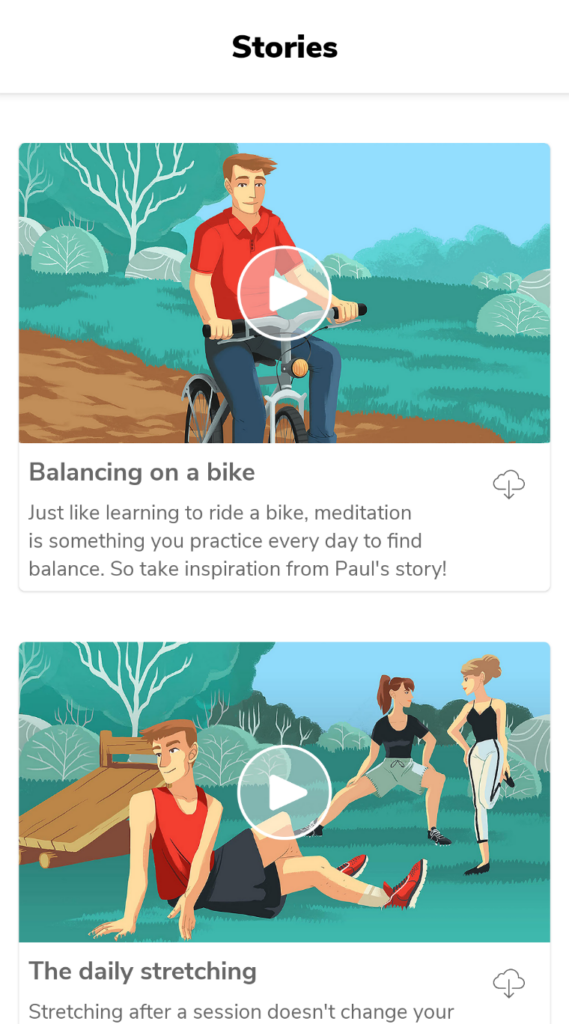
Fortunately Petit BamBou redeems itself with an outstanding “Stories” feature, comprising a set of short but striking animations that aim to explain the basic principles of meditation. This includes a story which offers comparison between meditating and riding a bike, in the way that both techniques must initially be laboriously learnt but gradually become reflexive, and that meditation can also be perceived as a way of finding a dynamic sense of balance within oneself. Short and engaging, I found these stories to be extremely effective at shedding light on more complex, often abstract, concepts, as well as providing encouragement for maintaining a regular practice. With their striking visual element and use of straightforward language, these animations are also very much suitable for children who are learning to meditate for the first time.
Sounds
By dedicating an entire section of the app to soothing background noise and music, Petit BamBou enables the user to listen to these sounds independent of their practice, which is an unusual but useful feature- ideal for providing a relaxing accompaniment to daily chores or a commute. The audio clips are separated into five sections: “Nature”, “Water”, “Cozy Atmosphere”, “Travel” and “Dreamworld”, meaning that it is easy to locate a particular sound or musical segment to suit one’s mood or preference. There is also an option for having a sound play for a certain duration of time, which is ideal if one is listening to assist with falling asleep, for example. This section of the app is regularly updated, meaning that the user is able to access an ever-expanding range of soothing background sounds and musical segments.
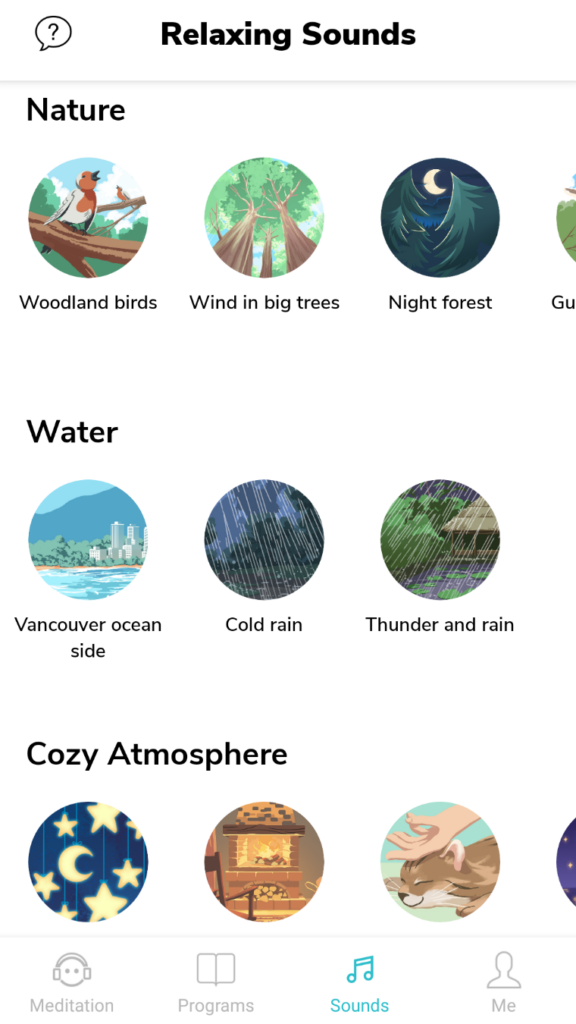
Accessibility and Downloads
As well as being available as a mobile app, users can also log into their account online via the Petit BamBou website. This means that the meditations and tools offered by Petit BamBou are easily accessible; however, it is worth being aware that the meditation timer, Reminder and Cardiac coherence tools are not available in the online format, and that it is also not possible to download any meditations or audio clips.
It is therefore advisable to use the Petit BamBou app in order to gain access to all of its available features, including the ability to download meditations and relaxing background sounds and music. This is particularly useful if one wishes to meditate offline, such as whilst travelling or commuting, when WiFi access may be limited or unavailable.
How much does Petit BamBou cost? Is it value for money?
Priced at £7.99 per month (or £66 annually), Petit BamBou sits within the same price bracket as other popular meditation apps such as Headspace. Although it is possible to use the app without a subscription, as the tools such as “Cardiac coherence”, “Calming breath”, “Stories” and the meditation timer are fully available, the catalogue of guided meditations that are free to use is extremely limited- comprising only the first eight sessions in the “Progression” set of meditations and the “Peaceful Sleep” series. This means that the user will arguably need to pay in order to truly gain a solid foundation in the practice of meditation; however, I feel that the high standard of the resources offered by the app makes the cost of a subscription worthwhile.
Conclusion
In a recent interview, co-founder Benjamin Blasco expressed how he hoped the app would help people “to cultivate serenity, deal with anxiety, and ensure that their minds and body are still for holistic well-being”. With its comprehensive and compassionate approach to meditative practice, as well as its ability to simplify difficult concepts through animation, I feel that Petit BamBou is successful in achieving these aims. Furthermore, the extensive support that is offered across six widely-spoken languages should hopefully ensure that as many people can benefit from its meditative guidance as possible.
I have been with petite bamboo for over a year and have found it to be a trusted friend including comments from them encouraging me along the way it has truly helped me to understand being vulnerable is a beautiful thing
This type of branding exploits a pre-established stereo type of Asians to achieve brand recognition. (No different from Aunt Jemima or Uncle Ben having been black domestic servants to sell food products.) Little Bambou is depicting a Buddhist monk to sell meditation exercises that are not Buddhist… and it names him Little Bamboo – which is a gross generalization of Asian culture and language.
Here is the bigger part of the problem – stero-typing is one step in the cycle of oppression. It sets up norms, conventions and expectations for people based on their race, ethnicity or region of origin. The problem with stereotyping people is that it then creates the justification for prejudice and that is then used to justify discrimination. This branding simply reenforces racial stereotyping.
I want to point out that the stereotype of little passive Asians puts east Asians at risk for exploitation. As someone who works in the social service field this manifests itself in very bad ways, especially for women.